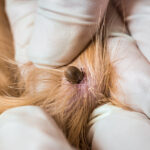A clean cat is a happy cat! Keeping claws, fur, and skin groomed goes a long way toward the happiness and health of your kitty. During the winter, you may notice your cat grooming themselves more and a lot of cat hair in your home. That means it may be time for a quick grooming session.
Cats shed all year long! But, if the weather is turning cooler, and you notice more and more shedding from your favorite feline, there are a few grooming things you can do at home to reduce the cat hair and keep your cat healthy.
Contrary to what many people believe, fur growth is related more to the amount of sunlight available than the actual temperature. Therefore, in the winter, a cat’s undercoat grows a thicker, heavier coat to keep them warm during the winter. In the springtime, a cat will shed that heavy winter coat in preparation for warmer temperatures and more sunlight.
Although cats seem to make a day out of leisurely grooming themselves, your cat may need some assistance during the heavier shedding seasons, especially if they are an older cat.
Cat’s Grooming Needs
Typically, cats do not need a bath like dogs do. In fact, we strongly recommend against submerging your cat in a bathtub! If you find that your cat does need a bath, make an appointment with a groomer or a veterinarian.
The amount of grooming required depends on the kind of coat a cat has and the cat’s age. While it’s typical to brush a cat once a week, that may not always be the case with short-haired cats. Older cats with mobility issues due to arthritis or obesity may need some extra help from their owners.
Winter Cat Grooming Tips for Skin, Fur, and Paws
We all know cats have their own agenda! So, if you are planning to groom your cat, make sure you have a little time on your hands and that your feline is feeling patient.
Tips for brushing your cat in the winter:
- Keep sessions short. If they growl, lower their ears, or flick their tail, it may be time for a break.
- Use a cat grooming brush. There are some brushes that only remove the loose top hair. Make sure you find one that reaches the undercoat. Your veterinarian can advise you on the best brush for your cat’s breed.
- Don’t force it. It’s best if your cat is relaxed and calm, so you may need to tire them out with a good play session before brushing. Don’t forget a reward at the end!
As you are brushing, take note of any changes in the cat’s fur. Healthy coats look shiny with clear skin underneath. An unhealthy coat may be matted with blemished, flaky skin. If fur is falling out, and skin is greasy, bumpy, or flaky, make an appointment with your vet.
After brushing your cat, take a quick glance at their paws and note any sores, cuts, splinters, or swelling between their toes and around their paw pads. If your cat ventures outdoors frequently, it’s a good idea to wipe their paws with a clean, damp cloth after their adventures.
If you notice any splinters, gently remove them with tweezers, or make an appointment to see your veterinarian.
Should you have additional questions about winter cat grooming tips or wish to schedule an appointment, give our office a call today.






